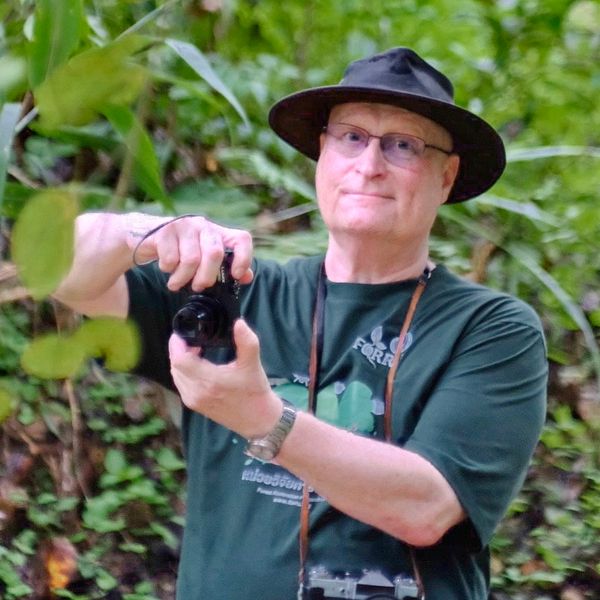ตีพิมพ์ครั้งแรกใน Samara ฉบับที่ 32 กรกฎาคม - ธันวาคม 2560 (จดหมายข่าวของ Millennium Seed Bank Partnership (MSBP))
องค์การสหประชาชาติ (UN) ได้ตั้งเป้าหมายในการฟื้นฟูพื้นที่ป่าขนาด 350 ล้านเฮกตาร์บนพื้นที่เสื่อมโทรมทั่วโลกภายในปี 2030 แต่คำถามคือ เมล็ดพันธุ์เหล่านี้จะมาจากไหน? เป้าหมายใหญ่ เช่น โครงการ “Trillion Trees Partnership” ของ WWF จะต้องอาศัยการเก็บเมล็ดในระดับเกือบเทียบเท่าอุตสาหกรรม อย่างไรก็ตาม ในปัจจุบันหลายประเทศยังขาดแคลนเครือข่ายการจัดหาเมล็ดไม้พันธุ์พื้นเมือง การเก็บเมล็ดจากป่าที่เหลืออยู่จึงยังคงมีความจำเป็น แต่กระบวนการในปัจจุบันมีข้อจำกัดหลายประการ เช่น ผู้เก็บเมล็ดต้องเดินฝ่าป่าทึบพร้อมกล้องส่องทางไกลเพื่อค้นหาผลไม้ที่สุกอยู่บนเรือนยอดไม้ ซึ่งมองเห็นได้เพียงเศษเสี้ยวจากพื้นดิน และแม้ว่าจะพบต้นไม้ที่ออกผลแล้ว เมล็ดอาจยังไม่สุกพอ ทำให้ต้องกลับมาเก็บซ้ำอีก ดังนั้น การเก็บเมล็ดด้วยวิธีการดั้งเดิมมักไม่มีประสิทธิภาพ คาดการณ์ได้ยาก และมีต้นทุนสูงตามมา
ข้อจำกัดข้างต้นทำให้เกิดคำถามว่า ทำไมไม่ลองมองหาต้นแม่ไม้จากมุมสูง? วิธีการนี้เคยถูกทดลองมาแล้วโดยใช้ภาพถ่ายความละเอียดสูงที่ถ่ายจากเครื่องบินที่ระดับความสูง 500-1,000 เมตร เพื่อค้นหาลักษณะเด่นของทรงพุ่มไม้ และพัฒนาเป็นไดโคโตมัสคีย์ (dichotomous key) สำหรับการจำแนกต้นไม้ (Gonzalez-Orozco, et al., 2010) นอกจากนี้ ยังมีงานวิจัยบางส่วนที่ประสบความสำเร็จในการใช้ภาพถ่ายแบบไฮเปอร์สเปกตรัมและ LiDAR (Baldeck, et al., 2015) อย่างไรก็ตาม เทคโนโลยีเหล่านี้มีค่าใช้จ่ายสูง และรายละเอียดที่สามารถตรวจจับได้จากเครื่องบินยังค่อนข้างจำกัด ด้วยการพัฒนาเทคโนโลยี อากาศยานไร้คนขับ (UAV หรือโดรน) ที่มีราคาย่อมเยาในปัจจุบัน กล้องดิจิทัลความละเอียดสูงสามารถถูกนำขึ้นบินใกล้กับเรือนยอดของป่าได้มากขึ้น ทำให้เกิดศักยภาพในการพัฒนาระบบจำแนกต้นไม้ที่มีความละเอียดสูงขึ้น ในขณะเดียวกันยังสามารถลดต้นทุนได้อย่างมีประสิทธิภาพอีกด้วย

คริสณา กำลังทดลองใช้ข้อมูลสามประเภท ได้แก่ 1) ลักษณะของทรงพุ่มไม้ 2) ลักษณะของใบ 3) การกรองภาพ
การระบุประเภท, รูปร่าง และการจัดเรียงใบสามารถทำได้ง่ายและบางชนิดมีลักษณะที่โดดเด่นชัดเจน การกรองภาพก็สามารถแยกลักษณะของทรงพุ่มไม้บางชนิดได้อย่างมีนัยสำคัญ แต่ผลลัพธ์ก็ขึ้นอยู่กับชนิดของต้นไม้และช่วงฤดูกาล โดยชนิดที่มีลักษณะเด่นเมื่อมีการแตกใบใหม่อาจกลายเป็นไม่สามารถแยกแยะได้ภายในเวลาเพียงไม่กี่สัปดาห์ต่อมา ดังนั้น เราจึงเห็นว่าโดรนสามารถใช้ในการค้นหาต้นไม้ที่มีลักษณะเด่นในช่วงที่พวกมันโดดเด่นที่สุด และสามารถติดตามดูการติดผลและการสุกของผลไม้ได้ในภายหลังโดยใช้แผนการบินอัตโนมัติ
แหล่งอ้างอิง
- Baldeck, C. A., G. Asner, R. Martin, C. Anderson, D. Knapp, J. Kellner, S. Wright, (2015). Operational Tree Species Mapping in a Diverse Tropical Forest with Airborne Imaging Spectroscopy. PLoS ONE 10(7): e0118403. doi:10.1371/journal.pone.0118403 Gonzalez
- Orozco, C., M. Mulligan, V. Trichon & A. Jarvis, (2010). Taxonomic identification of Amazonian tree crowns from aerial photography. Applied Vegetation Science. 13: 510–519, DOI: 10.1111/j.1654-109X.2010.01090.
หากสนใจสามารถอ่านงานวิจัยของคริสณาเพิ่มเติมได้ที่นี่: "Locating and identifying seed tree species for forest restoration in northern Thailand using an unmanned aerial vehicle" .


